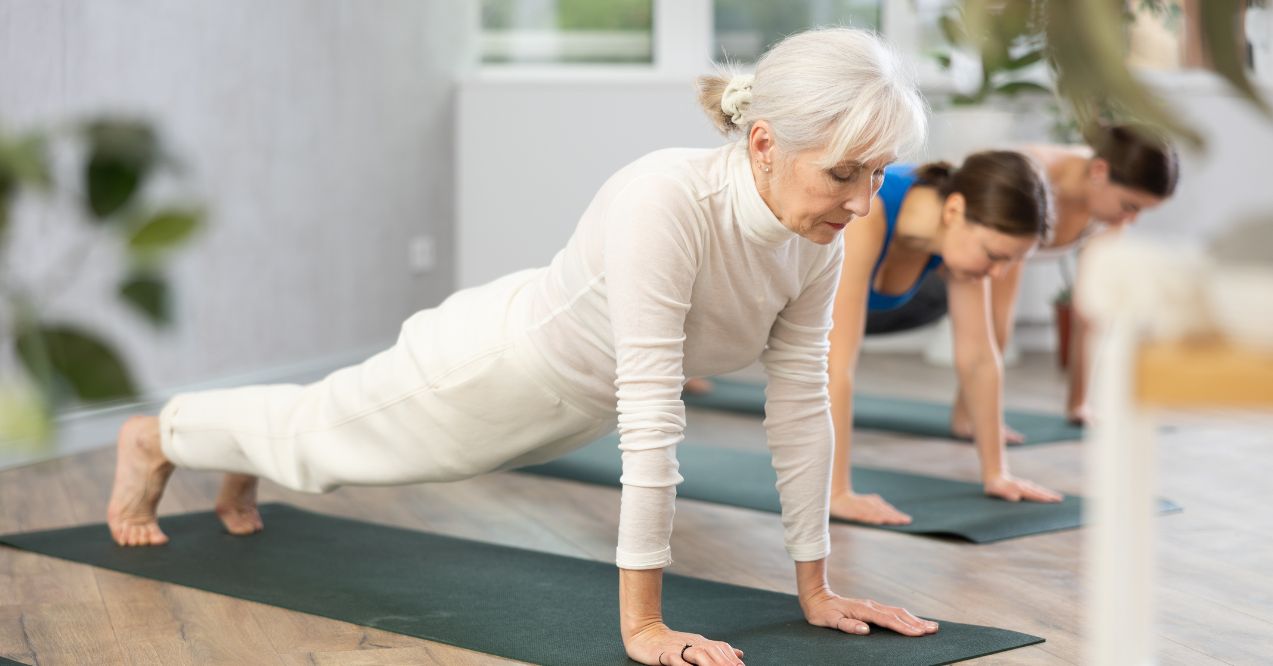Somatic Exercises for Weight Loss – Discover the Benefits And More
Seeking a holistic approach to weight loss? Discover somatic exercises for weight loss. Mindful movement meets effective results!


Somatic exercises for weight loss provide a unique approach to achieving your wellness goals. This mindful practice enhances body awareness and promotes overall well-being, supporting your weight management journey.
Somatic exercises focus on the mind-body connection, which plays an important role in maintaining a healthy weight. Let’s explore how these gentle yet powerful movements may contribute to your weight loss efforts and overall health.
What is Somatic Exercise?
Somatic exercise is a form of movement therapy emphasizing internal physical perception and experience. The term “somatic” relates to the body, particularly as distinct from the mind. Somatic exercises aim to bridge this gap, creating a strong connection between mental processes and physical sensations.
Key principles of somatic exercise are:
- Slow, deliberate movements
- Focus on internal sensations
- Emphasis on proper breathing techniques
- Improved body awareness and control
Somatic exercises prioritize how movements feel from within, unlike traditional exercises that often focus on external form. This internal focus helps individuals become more attuned to their bodies, leading to improved posture, reduced tension, and more efficient movement patterns.
How Does Somatics Help Me Lose Weight?
Somatic exercises contribute to weight loss efforts in several ways, despite not directly burning as many calories as high-intensity workouts:
- Stress Reduction – Chronic stress may lead to weight gain. Somatic exercises help activate the body’s relaxation response, potentially reducing stress-related eating behaviors.
- Improved Body Awareness – Enhanced body awareness might lead to better eating habits and a more intuitive understanding of hunger and fullness cues.
- Better Sleep – Somatic exercises might improve sleep quality, which is crucial for maintaining a healthy weight.
- Increased Mindfulness – The mindful nature of somatic exercises may extend to other areas of life, including eating habits.
- Enhanced Physical Function – Improved posture and movement efficiency might make other forms of exercise more effective and enjoyable.
Somatic exercises work best when combined with a balanced diet and other forms of physical activity for optimal weight loss results.
Best Somatic Exercises for Weight Loss
Certain somatic practices might be particularly beneficial for those looking to support their weight loss journey. These exercises help reduce stress, improve body function, and enhance overall well-being, indirectly supporting weight management efforts.
1. Wall Presses

Wall presses are a simple yet effective somatic exercise that improves body awareness and reduces tension.
How to perform wall presses:
- Stand with your back against a wall, feet hip-width apart and about 6 inches from the wall.
- Bend your knees slightly and press your lower back into the wall.
- Place your hands against the wall at shoulder height.
- Slowly press your hands into the wall, focusing on the sensation in your arms and chest.
- Hold for a few seconds, then slowly release the pressure.
- Repeat 5-10 times, paying attention to how your body feels throughout the movement.
Wall presses may improve posture, potentially reduce upper body tension, and enhance body awareness, supporting your overall wellness goals.
2. Yoga

Somatic yoga for weight loss combines traditional yoga practices with a heightened focus on internal sensations and mindful movement. This approach emphasizes:
- Controlled, deliberate movements
- Synchronization of breath with movement
- Attention to bodily sensations
- Improved balance and body control
Incorporating somatic yoga into your routine may help reduce stress, improve flexibility, and enhance overall body awareness. These benefits promote a more mindful approach to eating and movement, supporting weight loss efforts.
3. The Cannon

The Cannon is a somatic workout technique that helps release tension and promote relaxation.
Steps to perform The Cannon:
- Stand with your feet hip-width apart.
- Inhale deeply, raising your arms out to the sides.
- As you inhale, tense your muscles gradually.
- Hold your breath and the tension for a moment.
- Exhale forcefully through your mouth, releasing all tension and letting your arms fall naturally.
- Repeat 3-5 times, focusing on the contrast between tension and relaxation.
This exercise may help reduce stress and promote body awareness, potentially supporting weight management by reducing stress-related eating behaviors.
4. ENS Massage

ENS (Enteric Nervous System) massage is a gentle self-massage technique focusing on the abdominal area. While not directly related to weight loss, it might support overall digestive health and body awareness.
How to perform ENS massage:
- Lie on your back in a comfortable position.
- Place your hands on your abdomen.
- Gently massage your abdomen in a clockwise direction, using circular motions.
- Focus on your breathing and any sensations you feel in your abdomen.
- Continue for 3-5 minutes, maintaining a gentle and mindful touch.
Regular practice of ENS massage might improve your connection with your body, potentially leading to more mindful eating habits.
How Long Do Somatic Exercises Take?
The duration of somatic exercise sessions can vary greatly depending on your goals, schedule, and experience level. Here are some general guidelines:
- Short sessions – even 5-10 minutes of focused practice can be beneficial, especially for beginners or those with busy schedules.
- Medium sessions – 15-30 minutes allows for a more comprehensive practice, incorporating multiple exercises or techniques.
- Longer sessions – 45-60 minutes or more can provide a deep, immersive experience, often used in therapeutic settings or intensive workshops.
Consistency is more important than duration. Regular, shorter sessions can be more beneficial than infrequent, longer ones. Start with shorter sessions and gradually increase the duration as you become more comfortable with the practices.
How Many Somatic Exercises Should I Do Each Day?

The frequency of somatic exercises can vary based on individual needs and goals. Here are some general recommendations:
- For beginners – Start with 1-2 short sessions per day, focusing on one or two exercises.
- For regular practitioners – Aim for 2-3 sessions daily, incorporating a variety of exercises.
- For intensive practice – Some may benefit from 3-4 sessions per day, especially when addressing specific issues or during periods of high stress.
Key points to consider:
- Quality over quantity – Focus on performing exercises mindfully rather than rushing through a high number of repetitions.
- Listen to your body – Adjust the frequency and intensity based on how your body feels.
- Consistency is key – Regular practice, even if brief, is more beneficial than sporadic, lengthy sessions.
- Integrate into daily life – Try to incorporate somatic awareness into your regular activities, not just during dedicated exercise time.
Developing a somatic exercise plan that works for you may take some experimentation. Start with a few exercises and gradually expand your practice as you become more comfortable with the techniques.
In addition to regular exercise, incorporating supplements can support your weight management journey by enhancing your body’s natural processes. Click here to explore our selection of weight loss supplements and find the perfect addition to your healthy lifestyle.
Conclusion
Somatic exercises for weight loss offer a unique and valuable approach to supporting your weight management journey. These practices focus on body awareness, stress reduction, and mindful movement, complementing your diet and exercise regimen to help you achieve your health and fitness goals. The key to success with somatic exercises lies in consistent practice and patient attention to your body’s signals.
Somatic exercises may indirectly support weight loss by reducing stress, improving body awareness, and enhancing sleep quality. While they don’t burn many calories directly, they may complement a balanced diet and regular exercise routine by promoting mindful eating habits and reducing stress-related overeating.
For significant weight loss, high-intensity interval training (HIIT) is often considered most effective. It combines short bursts of intense exercise with periods of rest, boosting metabolism and burning calories efficiently. However, extreme weight loss should be approached cautiously and under professional guidance for safety and sustainability.
Somatic exercises might help release trauma by increasing body awareness and promoting relaxation. They allow individuals to reconnect with their bodies, potentially releasing physical tension associated with traumatic experiences. However, for trauma release, it’s crucial to work with a trained professional in a safe, supportive environment.
Sign up for our Healthy Living newsletter!
Advertisement. This site offers health, wellness, fitness and nutritional information and is designed for educational purposes only. You should not rely on this information as a substitute for, nor does it replace, professional medical advice, diagnosis, or treatment. If you have any concerns or questions about your health, you should always consult with a physician or other health-care professional. Do not disregard, avoid or delay obtaining medical or health related advice from your health-care professional because of something you may have read on this site. The use of any information provided on this site is solely at your own risk.










